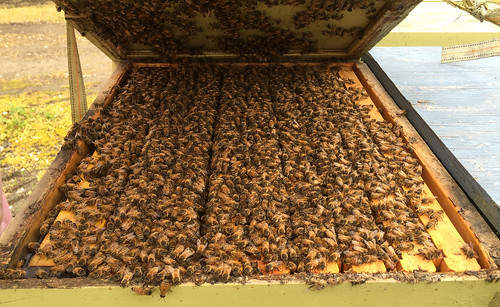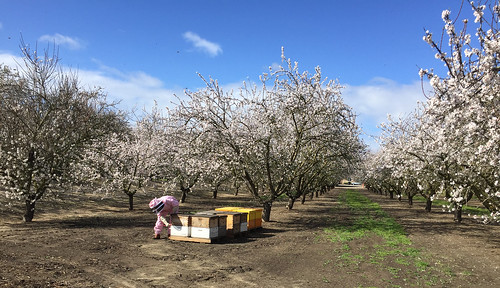Fees for bees: Auburn researcher focuses on paying for pollination
Article body
As bee and other pollinator populations and habitats continue to decline throughout the world, markets for pollination services have been growing in importance.
Studying the complexities of these markets is one area of research for Brittney Goodrich, assistant professor and extension economist with the College of Agriculture’s Department of Agricultural Economics and Rural Sociology.
In a study recently published in the journal Food Policy, Goodrich—who received her Ph.D. from the University of California, Davis, in 2017—focuses specifically on pollination fees in California, where 80 percent of the world’s almonds are produced.
“This research is important because almond pollination is a major source of income for beekeepers in the U.S.” she said. “I found that increases in honey bee colony winter mortality rates decrease beekeeping income by lowering the number of colonies they have available for almond pollination and lowering the per-colony fee they collect.”
Goodrich estimates that a 10 percent increase in a beekeeper’s winter mortality rate leads to an average decrease of 16 percent in total revenues from almond pollination, a substantial overall loss given that almond pollination is a primary source of U.S. commercial beekeepers’ revenues.
“Additionally, I estimate that when colony strength is accounted for, payments from the Emergency Assistance for Livestock, Honey bees and Farm-Raised Fish Program in 2016 would have compensated many beekeepers for less than half of their total revenue losses in almond pollination from the corresponding 10 percentage point increase in winter mortality rates,” she said. “This compensation rate is likely much lower than previously thought.”
Pollinators—including bees, butterflies, moths, bats, birds, beetles and other insects—contribute approximately $500 billion a year to global food production, with honey bees alone providing pollination services valued at $15 billion to $20 billion annually in the U.S.
The honey bee, Goodrich said, is one of the most important pollinator species to food security and ecosystems worldwide.
“I don’t see native bee health improving anytime soon,” she said. “A lot of this has to do with bee-friendly habitats disappearing. Native bees are declining not only in the United States but all over the world, so we’ll likely become more and more dependent on honey bee colonies for pollination services.”
Most of the honey bee colonies in the U.S. are managed as livestock, with commercial beekeepers often having 4,000 or more colonies and trucking them all over the country, she said.
There are more than 1 million acres of almond orchards in California, and every acre of almonds requires two honey bee colonies for proper pollination, Goodrich said. Almonds are 100-percent dependent on insects for pollination. California’s Central Valley consists entirely of farmland, so there’s little habitat to support native pollinators.
“There’s a mass migration of the U.S. honey bee colonies to California to complete this almond pollination each year, and this occurs around February,” she said. “California almonds use more than three-fourths of the honey bee colonies in the U.S., and they use them for a very small period of time.”
In comparison, all of the other spring-blooming pollinated crops in the United States use only about 35 percent of the colonies that almonds use for pollination, Goodrich said.
“So there is a great demand for these pollination services,” she said. “The pollination fees that beekeepers are paid for almonds are about $200 per colony. Whereas, for a crop that blooms a month later, like apples, fees will be around $30 per colony.”
Growers contract with beekeepers for these pollination services, Goodrich said. “A California almond grower usually contracts out in advance because often these honey bee colonies are coming from New York, Florida and other far-away places.
“Beekeepers transport colonies by semi-trucks—each holding around 400 colonies. Pollination fees range from about $165 per colony to about $240 per colony depending on the number of bees in a hive. This wide range in pollination fees is due to some growers requiring more bees per colony for pollination than other growers. Higher pollination fees are paid for colonies with a larger number of bees per colony.”
When health issues impact a bee-keeping operation, typically during the winter when there are high mortality rates, it often means surviving colonies are going to be weakened or smaller.
“There are contracts where growers are paying a base fee of $180 per colony for a certain number of bees,” she said. “If colonies have fewer bees than contracted, money will be subtracted from that base fee. There are varying levels of these contract arrangements.”
There are two types of pollination, Goodrich said, including managed pollination that is honey bee colonies managed by beekeepers and brought in for pollination services.
“There are also native pollinators that provide pollination services naturally—4,000 or more bee species are native to the U.S., while honey bees are not native. Most of the literature says that our native bee populations are decreasing.
“Honey bee colony populations have remained relatively stable, even during the years when we had Colony Collapse Disorder back in the early 2000s,” Goodrich said. “These colonies are managed by beekeepers, who can react to large losses by splitting colonies to make more.”
Because of the combination of many bee health issues, it is more expensive now for beekeepers to keep their colonies alive or to maintain a given number because more inputs are required, she said.
“As native pollinators decrease, it becomes more necessary to have honey bee colonies come in and pollinate our fruit and vegetable crops,” Goodrich said. “But honey bee colonies also can sometimes disrupt the native bees and pass diseases and pests on to them.”
In future research, Goodrich wants to explore colony strength issues from the beekeeping cost side.
“No one has studied if it’s economical for beekeepers to try and get these higher pollination fees or to use fewer inputs and take a lower fee,” she said.
“Also, there are many crops in Alabama that require pollination services, and there are a lot of beekeepers in Alabama. I’ve heard from producers in the state who say they can’t get enough bees from within Alabama to pollinate their crops. I’m interested in looking at how we can facilitate some of those contractual relationships between the beekeepers in Alabama and the crop producers who need them.”
Goodrich is also looking at the transportation of bee colonies from all U.S. states to California.
“There could be some colony strength issues as they relate to transportation,” she said. “If there are more bees per colony, it’ll mean heavier loads coming from the states supplying the colonies.”
Related Media
Media interested in this story can contact Communications Director Preston Sparks at (334) 844-9999 or preston.sparks@auburn.edu.
Auburn University is a nationally ranked land grant institution recognized for its commitment to world-class scholarship, interdisciplinary research with an elite, top-tier Carnegie R1 classification, life-changing outreach with Carnegie’s Community Engagement designation and an undergraduate education experience second to none. Auburn is home to more than 30,000 students, and its faculty and research partners collaborate to develop and deliver meaningful scholarship, science and technology-based advancements that meet pressing regional, national and global needs. Auburn’s commitment to active student engagement, professional success and public/private partnership drives a growing reputation for outreach and extension that delivers broad economic, health and societal impact.






